
If you have been listening to all the advice swirling around about cheese and wine pairing, well…you might be drinking a beer right now. It’s true: beer, in general, is more forgiving with cheese. But as with anything in life, the greater the risk, the greater the reward potential.
Unfortunately, the opposite is true as well: when a wine and cheese clash, they tend to do so dramatically. But happily, we’re just talking about food here, not brain surgery. Missteps happen, and they are OK. Here are two easy ways to up your batting average: always have extra wine on hand (tough sell, eh?) and adhere to the following guidelines.
-
Weigh the options.
In any pairing, one element shouldn’t drown out the other. A monster cabernet, for instance, is going to obliterate a diminutive disk of fresh goat cheese. Better to pull out a chunk of cheddar or dense, dry jack for the red and a light, bright sauvignon blanc for the goaty crottin.
-
Opt for acid.
Acidity is a cheese’s best friend: It’s the element that’s going to cleanse your palate between bites, readying it for more. It’s also going to amplify the acidity in cheese. In general, the lighter the wine, the higher the impression of acidity—the decision you need to make is whether you want to emphasize that acidity or counter it. A bright, zingy sauvignon blanc, for instance, will be bolstered by a fresh, tangy goat cheese or a chunk of feta. The same sauvignon, however, could provide satisfying contrast to a milky camembert.
-
Tame the tannins.
Tannins are naturally occurring components that come from the skins, seeds, and stems of grapes, as well as from the oak barrels often used to age wines. They can dry out your mouth, and are bitter and astringent in high levels. They also tend to be exaggerated by salt—something cheese tends to have a lot of. That said, tannins (in moderate levels) can work similarly to acidity to counter a cheese’s richness. Think of a dense, milky cheddar with a rich cabernet or zinfandel: not only will they match each other for size, but the wine’s tannins will give it purchase on the cheese’s concentrated milkfat.
-
Match ABV with fat.
Take away the alcohol from wine, and all you have is grape juice—not so interesting with cheese. Booze is a key part of the equation, yet it can pose its own challenges as salt and bitter flavors tend to fan its fire. Pair a high-alcohol wine with a dry, salty cheese and the cheese will taste even saltier and the wine more alcoholic; sip it with a bite of funky rind and all you’ll taste are the bitter notes of the cheese. The solution? Tamp down the alcohol in the wine with a cheese that has plenty of fat.
-
When in doubt, select something sweet.
Sweetness is a cheese lover’s friend: residual sugar in a wine can smooth over all the edges that prove ornery in wine-and-cheese pairings. The greatest example of the power of sweetness might be port, a sweet red out of Portugal. Port is full of the things most challenging to cheese—acid, tannins, and alcohol—and yet its sweetness makes it feel lush and smooth, a luxurious match for tangy blues. Sweet whites can work just as well.





Bourbon and blue cheese are a match made in heaven!
Bourbon based drinks, especially a well made old fashioned go great with most cheeses.
Absolutely!